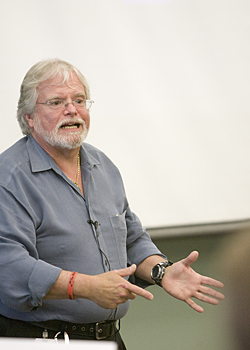
Ray opened his presentation with "Did You Know," a YouTube podcast produced by Shift Happens, that cites jaw-dropping demographic, educational and Internet-use statistics all pointing toward a worldwide shift in information sharing and learning. (Click here to see the podcast.) Ray then shared tips on how university-level educators can best reach students and boost instruction time through the use of computer-based technologies.
“The amount of technological information is more than doubling every two years,” Ray said, “and we live in a much more competitive environment than we've ever lived in before.”
He focused particularly on the educational value of podcasts and emphasized their versatility and portability before making the point that in this day and age “digital environments can happen anywhere.
“We're at a critical juncture,” Ray continued, “and a big challenge now is to get institutions to rethink the educational environment.”
Using a timeline of “knowledge processing,” he illustrated his point by noting different “communication revolutions” at different periods in history, starting with Neolithic grunts and proceeding through the Gutenberg printing press, and said that with the current technology explosion, humanity is now at another turning point.
“Very long ago, how we processed information was very elementary,” he said, “but when you look at that period of time from a distance, you can see the same information revolution and communication turmoil as we're experiencing now.”
In switching his focus to teaching methods, Ray said that while almost anyone with the available technology could create a podcast or Web site, not all content created would have educational value. He added that ultimately the real value of podcasts lay in their ability to be syndicated, or reproduced and distributed, and that by having the freedom to access valuable information repeatedly and at will, on-the-go learners could benefit both in and out of the classroom.
“Syndication feeds for playback on portable devices enhance the possibilities for both transmitting and receiving information,” Ray said. “And podcasting is not just one thing. It's a range of resources.”
Ray outlined the different types of podcasts, from simple audio feeds to video and audio feeds to enhanced podcasts, and addressed the uses of each, as well as his own strategies for creating them, before capping his lecture with examples of effective podcasts and opening the floor to questions and answers.
“The technology isn't the hard part,” he said. “The hard part is finding out how to enrich learning and make best use of class time.”
Article by Becca Hutchinson
Photo by Tyler Jacobson, AS '06

